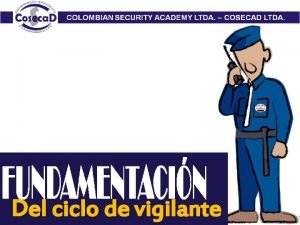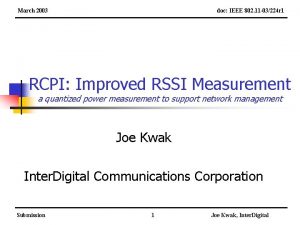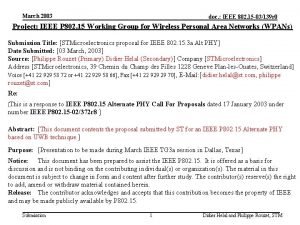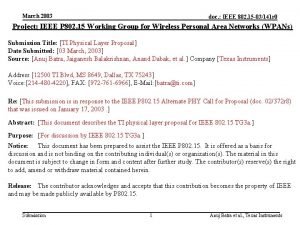March 2003 doc IEEE 802 11 03222 r





- Slides: 5

March 2003 doc. : IEEE 802. 11 -03/222 r 2 Proposed wording revisions to HT PAR Wednesday, March 12, 2003. Submission 1 Bruce Kraemer, Intersil; Colin Lanzl, Aware; Sean Coffey, TI

March 2003 doc. : IEEE 802. 11 -03/222 r 2 Section 18 - Additional Explanatory Details – Existing Text Item 12. In the process of formulating this PAR, it was found that there are multiple user scenarios. Accordingly, the task group will undertake the following steps: 1. Identify and define usage models, channel models and related MAC and application assumptions. Initial usage models envisioned include hot-spot, enterprise and residential; others may be included. 2. Identify and define evaluation metrics that characterize the important aspects of a particular usage model. The evaluation metrics may include but are not limited to the items listed in Table 1, provided as an illustration of the format. Table 1: Evaluation Metrics [table not included in this presentation version] #It is intended that throughput will be a primary comparison metric, and at least 100 Mbps is the mandatory minimum throughput for the highest throughput usage models. It is anticipated that the amended standard will contain a family of related modes, with different throughputs. It is anticipated that some of these modes will have throughputs that are substantially below 100 Mbps, but that are still substantially higher, given similar operating conditions, than any modes in the existing 802. 11 standard. Submission 2 Bruce Kraemer, Intersil; Colin Lanzl, Aware; Sean Coffey, TI

March 2003 doc. : IEEE 802. 11 -03/222 r 2 Section 18 - Additional Explanatory Details “Existing” and proposed new text on scope Previous version (r 0) of proposed first pargraph in Section 18: Item 12. The scope of the MAC and PHY enhancements assume a baseline of 802. 11, 802. 11 a, 802. 11 b, 802. 11 d, 802. 11 e, 802. 11 g, 802. 11 h, 802. 11 i, and 802. 11 j. The enhancements shall be to support higher throughput. New version of ad-hoc group proposed first paragraph in Section 18: Item 12. The scope of the MAC and PHY enhancements assume a baseline of 802. 11 and its amendments and anticipated amendments a, b, d, e, g, h, i, and j. The enhancements shall be to support higher throughput. The amendment shall not redefine mechanisms in the baseline that do not pertain to higher throughput. Submission 3 Bruce Kraemer, Intersil; Colin Lanzl, Aware; Sean Coffey, TI

March 2003 doc. : IEEE 802. 11 -03/222 r 2 Section 18 - Proposed new text on backwards compatibility/interoperation To be inserted as second paragraph in Section 18: Some of the modes of operation defined in the HT amendment shall be backwards compatible with 802. 11 a and/or 802. 11 g. Submission 4 Bruce Kraemer, Intersil; Colin Lanzl, Aware; Sean Coffey, TI

March 2003 doc. : IEEE 802. 11 -03/222 r 2 Section 18 - Proposed new text on scope and backwards compatibility/interoperability New version of ad-hoc group proposed start to Section 18: Item 12. The scope of the MAC and PHY enhancements assume a baseline of 802. 11 and its amendments and anticipated amendments a, b, d, e, g, h, i, and j. The enhancements shall be to support higher throughput. The amendment shall not redefine mechanisms in the baseline that do not pertain to higher throughput. Some of the modes of operation defined in the HT amendment shall be backwards compatible with 802. 11 a and/or 802. 11 g. Submission 5 Bruce Kraemer, Intersil; Colin Lanzl, Aware; Sean Coffey, TI








